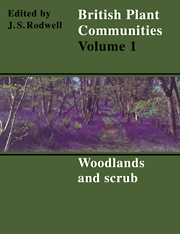Book contents
- Frontmatter
- Contents
- List of Figures
- Foreword
- Preface and Acknowledgements
- Preamble
- General Introduction
- Woodlands and Scrub
- Introduction to Woodlands and Scrub
- Key To Woodlands and Scrub
- Community Descriptions
- W1 Salix Cinerea-Galium Palustre woodland
- W2 Salix Cinerea-Betula Pubescens-Phragmites Australis Woodland
- W3 Salix Pentandra-Carex Rostrata Woodland
- W4 Betula Pubescens-Molinia Caerulea Woodland
- W5 Alnus Glutinosa-Carex Paniculata Woodland
- W6 Alnus Glutinosa-Urtica Jzozca Woodland
- W7 Ainus Glutinosa-Fraxinus Excelsior-Lysimachia Nemorum Woodland
- W8 Fraxinus Excelsior-Acer Campestre-Mercurialis Perennis Woodland
- W9 Fraxinus Excelsior-Sorbus Aucuparia-Mercurialis Perennis Woodland
- W10 Quereus Robur-Pteridium Aquilinum-Rubus Fruticosus Woodland
- W11 Quereus Petraea-Betula Pubescens-Oxalis Acetosella Woodland
- W12 Fagus Sylvatica-Mercurialis Perennis Woodland
- W13 Taxus Baccata Woodland
- W14 Fagus Sylvatica-Rubus Fruticosus Woodland
- W15 Fagus Sylvatica-Deschampsia Flexuosa Woodland
- W16 Quereus spp.-Betula spp.-Deschampsia Flexuosa Woodland
- W17 Quereus Petraea-Betula Pubescens-Dicranum Majus Woodland
- W18 Pinus Sylvestris-Hylocomium Splendens Woodland
- W19 Juniperus Communis Ssp. Communis-Oxalis Acetosella Woodland
- W20 Salix Lapponum-Luzula Sylvatica Scrub
- W21 Crataegus monogyna-Hedera helix scrub
- W22 Prunus Spinosa-Rubus Fruticosus Scrub
- W23 Ulex Europaeus-Rubus Fruticosus Scrub
- W24 Rubus Fruticosus-Holcus Lanatus Underscrub
- W25 Pteridium Aquilinum-Rubus Fruticosus Underscrub
- Index of Synonyms to Woodlands and Scrub
- Index of Species in Woodlands and Scrub
- Bibliography
W21 - Crataegus monogyna-Hedera helix scrub
Published online by Cambridge University Press: 04 July 2020
- Frontmatter
- Contents
- List of Figures
- Foreword
- Preface and Acknowledgements
- Preamble
- General Introduction
- Woodlands and Scrub
- Introduction to Woodlands and Scrub
- Key To Woodlands and Scrub
- Community Descriptions
- W1 Salix Cinerea-Galium Palustre woodland
- W2 Salix Cinerea-Betula Pubescens-Phragmites Australis Woodland
- W3 Salix Pentandra-Carex Rostrata Woodland
- W4 Betula Pubescens-Molinia Caerulea Woodland
- W5 Alnus Glutinosa-Carex Paniculata Woodland
- W6 Alnus Glutinosa-Urtica Jzozca Woodland
- W7 Ainus Glutinosa-Fraxinus Excelsior-Lysimachia Nemorum Woodland
- W8 Fraxinus Excelsior-Acer Campestre-Mercurialis Perennis Woodland
- W9 Fraxinus Excelsior-Sorbus Aucuparia-Mercurialis Perennis Woodland
- W10 Quereus Robur-Pteridium Aquilinum-Rubus Fruticosus Woodland
- W11 Quereus Petraea-Betula Pubescens-Oxalis Acetosella Woodland
- W12 Fagus Sylvatica-Mercurialis Perennis Woodland
- W13 Taxus Baccata Woodland
- W14 Fagus Sylvatica-Rubus Fruticosus Woodland
- W15 Fagus Sylvatica-Deschampsia Flexuosa Woodland
- W16 Quereus spp.-Betula spp.-Deschampsia Flexuosa Woodland
- W17 Quereus Petraea-Betula Pubescens-Dicranum Majus Woodland
- W18 Pinus Sylvestris-Hylocomium Splendens Woodland
- W19 Juniperus Communis Ssp. Communis-Oxalis Acetosella Woodland
- W20 Salix Lapponum-Luzula Sylvatica Scrub
- W21 Crataegus monogyna-Hedera helix scrub
- W22 Prunus Spinosa-Rubus Fruticosus Scrub
- W23 Ulex Europaeus-Rubus Fruticosus Scrub
- W24 Rubus Fruticosus-Holcus Lanatus Underscrub
- W25 Pteridium Aquilinum-Rubus Fruticosus Underscrub
- Index of Synonyms to Woodlands and Scrub
- Index of Species in Woodlands and Scrub
- Bibliography
Summary
Synonymy
Scrub and Chalk scrub auct. angl.; Scrub associations Tansley 1911; Progressive scrub Moss 1913; Retrogressive scrub Moss 1913; Thicket scrub Salisbury 19186; Woodland scrub Salisbury 19186; Fruticetum Tansley 1939 p.p.
Constant species
Crataegus monogyna, Rubus fruticosus agg., Hedera helix.
Rare species
Himantoglossum hircinum, Orchis militaris, O. purpurea, O. simia, Silene nutans, Seseli libanotis.
Physiognomy
The Crataegus monogyna-Hedera helix scrub is a compendious community which includes most of the serai thorn scrub and many hedges in the British Isles. The vegetation is always dominated by various mixtures of smaller trees and shrubs, undershrubs and woody climbers and sprawlers but physiognomically it is quite diverse and sometimes difficult to separate from more open herbaceous vegetation with scattered woody plants on the one hand and woodland on the other. Typically, however, the woody cover of the community as defined here is dense, often closed or almost so, such that half-and-half mixtures of grassland and scrub would be considered as mosaics of this kind of vegetation and others. The canopy can, however, be quite low, sometimes little more than a metre high and only rarely more than 5 m. But, although stands can be very uneven-topped, where once discrete groups of shrubs, trees and undershrubs are coalescing, the woody cover is characteristically unstratified. Saplings of some species of taller trees are common in the community and occasional specimens may protrude a little but they never form an overtopping canopy.
In floristic terms, the woody component of this vegetation is quite varied, being influenced not only by edaphic differences but also by the availability of seedparents and the vagaries of dispersal and establishment; and, once the canopy has begun to close, there is some competitive interplay between certain of the species. However, a strong common element is provided by various spinose plants. Crataegus monogyna is the most frequent of these overall and it is often the most abundant tree: it is usùally among the first invaders of the various kinds of neglected herbaceous vegetation from which the community often develops and, except on shallower soils (usually rendzinas here), it can be very abundant from the start.
- Type
- Chapter
- Information
- British Plant Communities , pp. 333 - 346Publisher: Cambridge University PressPrint publication year: 1991

